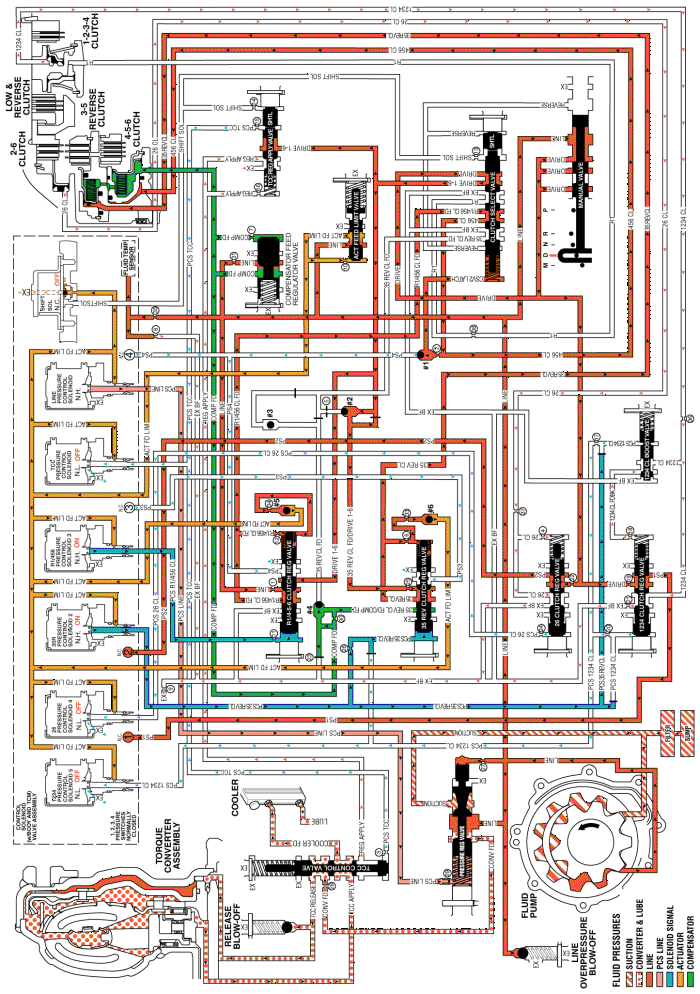Orlando |
||||||||
|
|
|
|||||||
If the transmission encounters an electrical component malfunction, the transmission will default to Fifth gear. All solenoids will default to their normal state. If the torque converter clutch is applied, it will release. The transmission will remain in Drive Range - Fifth Gear Default until the condition is corrected. Reverse (R) range can also still be selected. This default action enables the vehicle to be safely driven to a service centre.
The 35R PC solenoid 2 defaults to its normally-high state (ON), allowing actuator feed limit fluid to enter the PCS 35 reverse clutch fluid circuit. PCS 35 reverse clutch fluid is routed through orifice #26 to the 3-5-reverse clutch regulator valve. If the transmission is operating in First, Second, Fourth or Sixth gear when an electrical malfunction occurs, the 3-5-reverse clutch will apply. If the transmission is operating in Third or Fifth gear when the electrical malfunction occurs, the 3-5-reverse clutch remains applied.
PCS 35 reverse clutch fluid, at the 3-5-reverse clutch regulator valve, opposes 3-5-reverse clutch regulator valve spring force and 35 reverse clutch feedback fluid pressure to regulate 35 reverse clutch feed/drive 1-6 pressure into the 35 reverse clutch circuit. The 35 reverse clutch fluid is then routed to the 3-5-reverse clutch assembly, through orifice #6 to the spring end of the 3-5-reverse clutch regulator valve and through orifice #33 to the #6 ball check valve. When the 3-5-reverse clutch regulator valve is in this position, PS3 fluid exhausts through the valve allowing the normally-closed #3 pressure switch to close.
35 reverse clutch fluid enters the 3-5-reverse and 4-5-6 clutch housing assembly to move the 3-5 reverse clutch piston against spring force and compensator feed fluid pressure to apply the 3-5-reverse clutch plates.
35 reverse clutch feed fluid unseats the #6 ball check valve, allowing excess pressure to pass into the actuator feed limit circuit. This helps to control clutch apply fluid pressure and clutch apply feel.
The R1/456 PC solenoid 3 defaults to its normally-high state (ON), allowing actuator feed limit fluid to enter the PCS R1/456 clutch fluid circuit. PCS R1/456 clutch fluid is routed through orifice #11 to the R1/456 clutch regulator valve. If the transmission is operating in First, Second or Third gear when an electrical malfunction occurs, the 4-5-6 clutch will apply. If the transmission is operating in Fourth, Fifth or Sixth gear when the electrical malfunction occurs, the 4-5-6 clutch remains applied.
PCS R1/456 clutch fluid, at the R1/4-5-6 clutch regulator valve, opposes R1/4-5-6 clutch regulator valve spring force and orificed R1/456 clutch feed fluid pressure to regulate line pressure into the R1/456 clutch feed circuit. R1/456 clutch feed fluid is then routed to the clutch select valve, through orifice #12 to the spring end of the R1/4-5-6 clutch regulator valve, and through orifice #34 to ball check valve #5. When the R1/4-5-6 clutch regulator valve is in this position, PS4 fluid exhausts through the valve allowing the normally-closed #4 pressure switch to close.
R1/456 clutch feed fluid passes through the clutch select valve and enters the 456 clutch circuit. 456 clutch fluid is routed to the 4-5-6 clutch assembly, and through orifice #2 to the #1 ball check valve.
Orificed 456 clutch fluid pressure seats the #1 ball check valve against the exhausting PS4 fluid passage. 456 clutch fluid is then directed into the CSV2 latch circuit to replace the exhausting PS4 pressure and is routed to the clutch select valve. CSV2 latch fluid combines with clutch select valve spring force and holds the valve in this position during all six forward gear ranges.
456 clutch fluid enters the 3-5-reverse and 4-5-6 clutch housing assembly, and moves the 4-5-6 clutch piston against spring force and compensator feed pressure to apply the 4-5-6 clutch plates.
R1/456 clutch feed fluid unseats the #5 ball check valve, allowing excess pressure to pass into the actuator feed limit circuit. This helps to control clutch apply fluid pressure and clutch apply feel.
If the transmission is in First, Second, Third or Fourth gear when an electrical condition commands a protection mode, the 1234 PC solenoid 5 defaults to its normally-low state (OFF), allowing PCS 1234 clutch fluid pressure to exhaust and the 1-2-3-4 clutch to release.
If the transmission is in Second or Sixth gear when an electrical condition commands a protection mode, the 26 PC solenoid 4 defaults to its normally-low state (OFF), allowing PCS 26 clutch fluid pressure to exhaust and the 2-6 clutch to release.
If the TCC is applied when an electrical condition commands a protection mode, the TCC PC solenoid defaults to its normally-low state (OFF), allowing PCS TCC fluid to exhaust and the TCC to release.
The transmission default gear may be Fourth, rather than Fifth gear, depending on engine size and effective final drive ratio. If the transmission encounters an electrical component malfunction, the transmission will default to Fourth gear. All solenoids will default to their normal state. If the torque converter clutch is applied, it will release. The transmission will remain in Drive Range - Fourth Gear Default until the condition has been corrected. Reverse (R) range can also still be selected. This default action enables the vehicle to be safely driven to a service centre.

| © Copyright Chevrolet. All rights reserved |